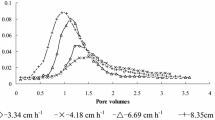Abstract
Water scarcity makes treated wastewater an unavoidable supplementary irrigation water source. Furthermore treated municipal wastewater quality depends on the fresh water quality and usage as well as on the wastewater treatment plant’s degree and efficiency. The main recipient of all chemical compounds contained in this effluent, via irrigation, is soil. Models have been developed to predict factors involved in contaminants movement phenomenon through soil. In the reused effluent, chloride is much of a concern as a conservative pollutant. In this work the chloride breakthrough curves were determined for a clay-loam packed soil column by applying a one dimensional advection dispersion equation, to obtain estimates of the solute transport parameters. The comparisons between experimental and calculated results were satisfactory and also conclusions were derived about the flow conditions in the soil column and its uniformity. Also comparisons were made between calculated and cited in the literature values of the parameters satisfactorily.



Similar content being viewed by others
References
Alvarez-Benedi J, Regalado CM, Ritter A, Bolado S (2005) Charaxterization of solute transport through miscible displacement experiments. In: Alvarez-Benedi J, Munoz-Carpena R (eds) Soil-water solute process characterization An intergrated approach. CRC Press, London, pp 392–428
Appelo CA, Postma D (1996) Geochemistry groundwater and pollution. A. A. Balkema, Amsterdam
Bourazanis G, Rizos S, Kerkides P (2015) Soil water balance in the presence of a shallow water table. In: Proceedings of 9th WORLD CONGRESS «Water Resources Management in a Changing World: Challenges and Opportunities». Istanbul, Turkey: European Water Resources Association (EWRA)
Bourazanis G, Katsileros A, Kosmas C, Kerkides P (2016) The effect of treated municipal wastewater and fresh water on saturated hydraulic conductivity of a clay-loamy. Water Resour Manage, Soil. doi:10.1007/s11269-016-1307-9
Brusseau ML (1994) Transport of reactive contaminants in heterogeneous porous media. Rev Geophys 32:285–313
Chapman HD (1965) Cation-exchange Capacity. In: Black CA (ed) Method of soil analysis, Part 2: chemical and microbiological properties. Am Soc Agron, Madison, pp 891–900
Coats KH, Smith BD (1956) Dead end pore volume and dispersion in porous media. Soc Pet Eng J 4:73–84
Dhaliwal BS, Grimes MM, Neketin TH, Peterson J, Richard D, Synnott JC et al (1985) Simplified laboratory procedures for wastewater examination, 2nd edn. Water Pollution Control Federation, Washington, DC
Gee GW, Bauder JW (1986) Particle-size analysis. In: Klute A (ed) Agron monograph No 9 methods of soil analysis. Part 1 physical and mineralogical methods, 2nd edn. ASA Inc. & SSSA Inc., Madison, pp 383–411
Jury WA, Horton R (2004) Soil physics, 6th edn. Wiley, New Jersey
Klute A, Dirksen C (1986) Hydraulic conductivity and diffusivity: laboratory methods. In: Klute A (ed) Agron monograph No 9 methods of soil analysis part 1-physical and mineralogical methods, 2nd edn. SSSA Book Series 5, pp 694–700
Marshall TJ, Holmes TW, Rose CW (1996) Soil Physics, 3rd edn. Cambridge University Press, New York
Millington RJ, Quirk JP (1961) Permeability of porous solids. Trans Faraday Soc 57:1200–1207
Nelson DW, Sommers LE (1996) Total carbon, organic carbon 7 organic matter. In: Bigham JM (ed) Methods of soil analysis. Part 3 chemical methods. ASA Inc. & SSSA Inc., Madison, pp 961–1010
Radcliffe DE, Simunek J (2010) Soil physics with hydrus modeling and aplications. CRC Press Taylor and Francis Group, London
Shukla MK (2014) Soil physics an introduction. CRC Press (Taylor and Francis Group), New York
Simunek J, van Genuchten MT, Sejna M, Toride N, Leij FJ (1999) The STANMOD computer software for evaluating solute transport in porous media using analytical solutions of convection-dispersion equation. Salinity Laboratory Agricultural Research Service U.S. Department of Agriculture, Riverside
Toride N, Leij FJ, van Genuchten MT (1995) The CXTFIT code for estimating transport parameters from laboratory or field tracer experiments. Version 2.0, Research Report No. 137. U. S. Salinity Laboratory, USDA, ARS, Riverside
Winton K, Weber JD (1996) A review of field lysimeter studies to describe the environmental fate of pesticides. Weed Technol 10:202–209
Acknowledgments
The Greek Ministry of Rural Development and Food and the former Prefecture of Laconia for funding the project are duly acknowledged.
Author information
Authors and Affiliations
Corresponding author
Rights and permissions
About this article
Cite this article
Bourazanis, G., Psychogiou, M. & Nikolaou, N. Chloride Transport Parameters Prediction for a Clay-Loam Soil Column. Bull Environ Contam Toxicol 98, 378–384 (2017). https://doi.org/10.1007/s00128-016-1867-7
Received:
Accepted:
Published:
Issue Date:
DOI: https://doi.org/10.1007/s00128-016-1867-7




